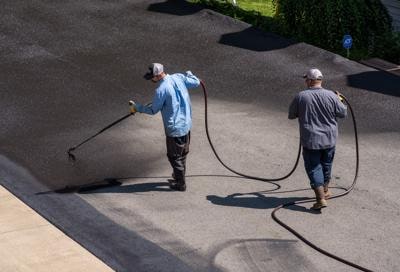Raise Commercial Charm: Warm Mix Asphalt Sealing for Angled Parking Lots
Raise Commercial Charm: Warm Mix Asphalt Sealing for Angled Parking Lots
Blog Article
Hot Mix Asphalt: A Lasting Service for Pavement
Warm Mix Asphalt (HMA) has emerged as a leading lasting choice for sidewalk options, offering a myriad of environmental benefits and cutting-edge technologies. As the demand for environmentally friendly building and construction practices expands, checking out the subtleties of HMA's sustainability can offer beneficial insights right into the future of pavement remedies.
Environmental Benefits of Hot Mix Asphalt

In Addition, Hot Mix Asphalt aids to minimize city warmth island effects. Its dark color takes in sunshine, lowering the amount of warm mirrored back into the environment compared to lighter-colored pavements. This can decrease ambient temperatures in city locations, reducing the need for cooling and eventually decreasing power usage.
Additionally, Warm Mix Asphalt adds to boosted stormwater monitoring. Its permeable nature enables water to reenergize and penetrate the sidewalk groundwater products, reducing runoff and the danger of flooding. These ecological advantages make Warm Mix Asphalt a sustainable selection for leading freeways and roadways.
Power Performance in HMA Manufacturing
Is power performance an important aspect in the manufacturing of Warm Mix Asphalt (HMA)? Definitely. Power plays a considerable function in the manufacturing of HMA, affecting both expense and environmental sustainability. One vital facet of power effectiveness in HMA production is using warm mix asphalt (WMA) technologies (commercial parking lot paving). WMA allows for the mixing and positioning of asphalt at reduced temperature levels contrasted to standard warm mix asphalt, leading to decreased power usage during production. This process not just reduces gas usage however also reduces greenhouse gas discharges, making it a much more eco-friendly choice.
Furthermore, improvements in plant technologies have led to even more energy-efficient HMA production procedures. Modern plants are developed with attributes like recycled asphalt pavement (RAP) processing capabilities, effective burner systems, and enhanced insulation, all contributing to energy financial savings. By enhancing power usage in HMA manufacturing, the sector can decrease its carbon impact while preserving high-grade pavement products. Energy effectiveness is, for that reason, a crucial factor to consider in making certain the sustainability of Warm Mix Asphalt production.
Recyclability of Warm Mix Asphalt
The recyclability of Warm Mix Asphalt (HMA) is an essential aspect of its sustainability and long-term environmental impact. HMA is among one of the most recycled materials in the United States, with over 100 million lots of redeemed see here now asphalt pavement (RAP) being reused yearly in new sidewalk building and construction. Recycling HMA provides a number of ecological advantages, such as reducing the need for virgin materials, reducing power intake throughout manufacturing, and lowering the quantity of waste sent out to landfills.
The process of recycling HMA entails milling the existing pavement, squashing it into smaller items, and mixing it with brand-new accumulation and asphalt binder to create a recycled mix. Overall, the recyclability of HMA plays a substantial function in promoting lasting methods within the sidewalk market.

Long-Term Efficiency of HMA
Asphalt pavements demonstrate durability and durability over an extended period, mirroring the long-lasting efficiency of Warm Mix Asphalt (HMA) In addition, advancements in HMA innovation, such as the use of polymer-modified binders and warm mix asphalt, have further improved the durability and durability of HMA sidewalks. By focusing on top quality construction and upkeep techniques, HMA proceeds to confirm itself as a lasting and cost-efficient option for resilient pavement infrastructure.

HMA: Resilience and Sustainability
Demonstrating both durability and sustainability, Warm Mix Asphalt (HMA) has come to be a cornerstone in the building of durable pavement infrastructures - regrading. HMA's durability originates from its ability to hold up against heavy lots, severe weather, and high web traffic volumes, making it a trusted choice for roadways, highways, and airport terminal runways. The structure of HMA, which typically includes accumulations, binder, and filler, plays a vital role in enhancing its longevity and resistance to damage
Additionally, HMA's sustainability hinges on its recyclability and energy-efficient manufacturing process. The capacity to reuse recovered asphalt sidewalk (RAP) in new HMA mixes minimizes the need for virgin materials and reduces the ecological influence of pavement building and upkeep. In addition, the power efficiency of producing HMA depends on its lower mixing read more temperature levels contrasted to various other pavement materials, leading to reduced energy usage check over here and greenhouse gas discharges.
Verdict
In verdict, warm mix asphalt (HMA) uses a sustainable option for sidewalk with its ecologically pleasant qualities. HMA's recyclability, power effectiveness in manufacturing, and long-lasting sturdiness make it an environmentally friendly choice for roadway building.
HMA is one of the most recycled materials in the United States, with over 100 million tons of recovered asphalt pavement (RAP) being recycled annually in new sidewalk building.The procedure of recycling HMA entails milling the existing sidewalk, crushing it into smaller sized items, and mixing it with brand-new accumulation and asphalt binder to develop a recycled mix.Asphalt sidewalks show durability and strength over a prolonged duration, reflecting the lasting performance of Warm Mix Asphalt (HMA) Additionally, improvements in HMA technology, such as the usage of polymer-modified binders and warm mix asphalt, have better improved the longevity and durability of HMA sidewalks. The ability to recycle redeemed asphalt pavement (RAP) in brand-new HMA combinations decreases the need for virgin materials and reduces the ecological impact of pavement building and construction and maintenance.
Report this page